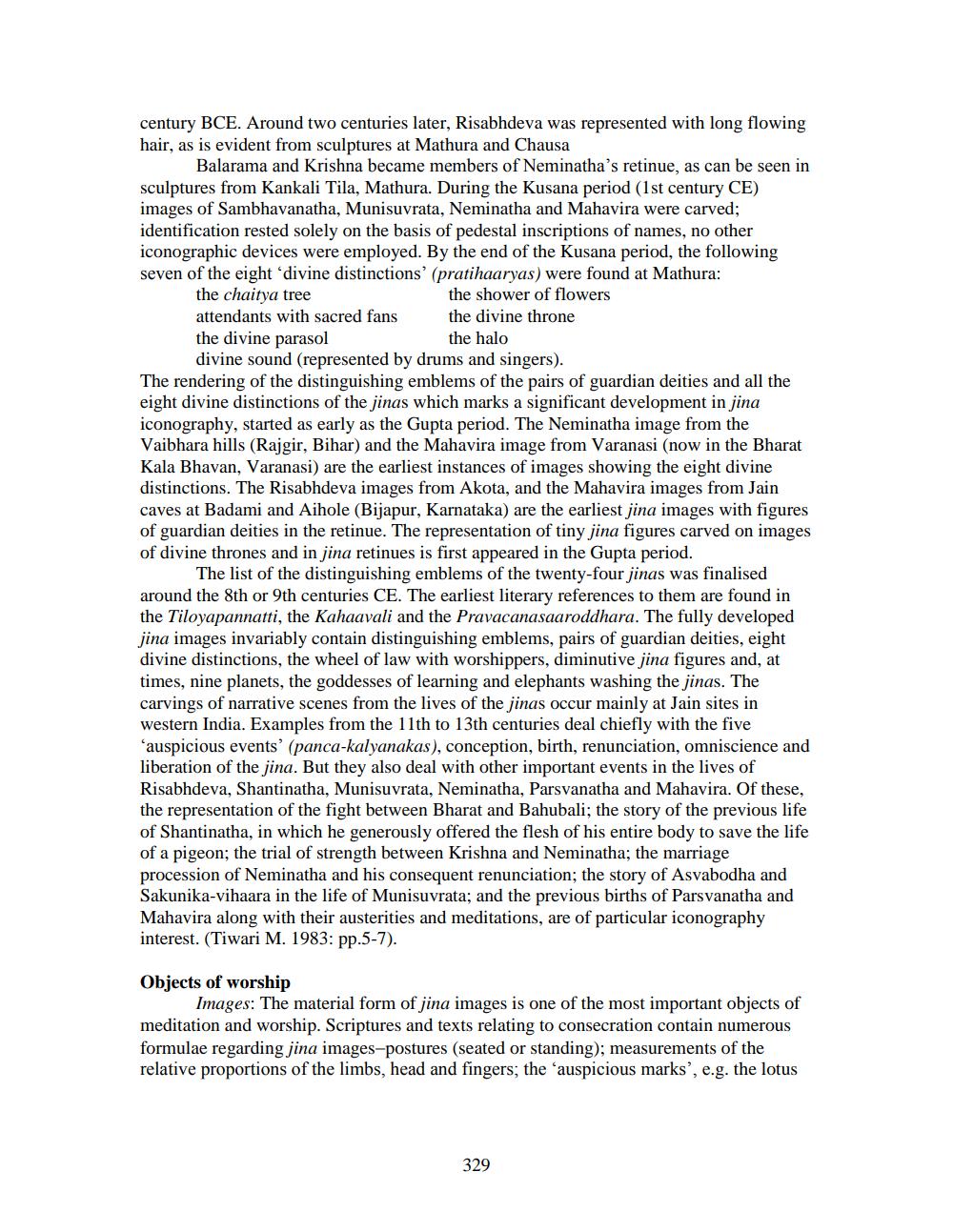________________
century BCE. Around two centuries later, Risabhdeva was represented with long flowing hair, as is evident from sculptures at Mathura and Chausa
Balarama and Krishna became members of Neminatha's retinue, as can be seen in sculptures from Kankali Tila, Mathura. During the Kusana period (1st century CE) images of Sambhavanatha, Munisuvrata, Neminatha and Mahavira were carved; identification rested solely on the basis of pedestal inscriptions of names, no other iconographic devices were employed. By the end of the Kusana period, the following seven of the eight divine distinctions' (pratihaaryas) were found at Mathura: the chaitya tree
the shower of flowers attendants with sacred fans the divine throne the divine parasol
the halo divine sound (represented by drums and singers). The rendering of the distinguishing emblems of the pairs of guardian deities and all the eight divine distinctions of the jinas which marks a significant development in jina iconography, started as early as the Gupta period. The Neminatha image from the Vaibhara hills (Rajgir, Bihar) and the Mahavira image from Varanasi (now in the Bharat Kala Bhavan, Varanasi) are the earliest instances of images showing the eight divine distinctions. The Risabhdeva images from Akota, and the Mahavira images from Jain caves at Badami and Aihole (Bijapur, Karnataka) are the earliest jina images with figures of guardian deities in the retinue. The representation of tiny jina figures carved on images of divine thrones and in jina retinues is first appeared in the Gupta period.
The list of the distinguishing emblems of the twenty-four jinas was finalised around the 8th or 9th centuries CE. The earliest literary references to them are found in the Tiloyapannatti, the Kahaavali and the Pravacanasaaroddhara. The fully developed jina images invariably contain distinguishing emblems, pairs of guardian deities, eight divine distinctions, the wheel of law with worshippers, diminutive jina figures and, at times, nine planets, the goddesses of learning and elephants washing the jinas. The carvings of narrative scenes from the lives of the jinas occur mainly at Jain sites in western India. Examples from the 11th to 13th centuries deal chiefly with the five 'auspicious events' (panca-kalyanakas), conception, birth, renunciation, omniscience and liberation of the jina. But they also deal with other important events in the lives of Risabhdeva, Shantinatha, Munisuvrata, Neminatha, Parsvanatha and Mahavira. Of these, the representation of the fight between Bharat and Bahubali; the story of the previous life of Shantinatha, in which he generously offered the flesh of his entire body to save the life of a pigeon; the trial of strength between Krishna and Neminatha; the marriage procession of Neminatha and his consequent renunciation; the story of Asvabodha and Sakunika-vihaara in the life of Munisuvrata; and the previous births of Parsvanatha and Mahavira along with their austerities and meditations, are of particular iconography interest. (Tiwari M. 1983: pp.5-7).
Objects of worship
Images: The material form of jina images is one of the most important objects of meditation and worship. Scriptures and texts relating to consecration contain numerous formulae regarding jina images-postures (seated or standing); measurements of the relative proportions of the limbs, head and fingers; the 'auspicious marks', e.g. the lotus
329




